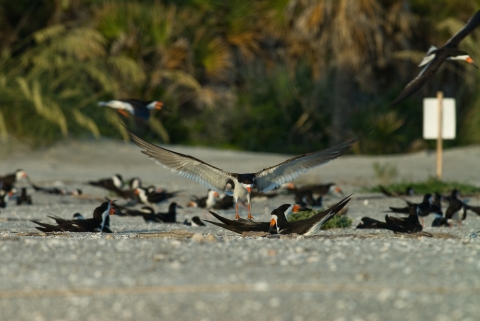About Us
Egmont Key NWR was designated as a national wildlife refuge in 1974. Egmont Key is managed by the U.S. Fish and Wildlife Service as a national wildlife refuge national wildlife refuge
A national wildlife refuge is typically a contiguous area of land and water managed by the U.S. Fish and Wildlife Service for the conservation and, where appropriate, restoration of fish, wildlife and plant resources and their habitats for the benefit of present and future generations of Americans.
Learn more about national wildlife refuge to protect the island’s diverse natural, cultural, and historical features. Egmont Key is also cooperatively managed as a unit of the Florida Park Service as Egmont Key State Park. Egmont Key is on the National Register of Historic Places for playing a prominent role in Florida’s Seminole Indian Wars, the Civil War, and the Spanish-American War. Situated at the mouth of Tampa Bay, this remote island preserves the remains of historic Fort Dade and is home to an over 100-year-old lighthouse. It also provides important habitat for nesting sea turtles, gopher tortoises, over 30,000 nesting pairs of birds, and other wildlife. Bird sanctuaries on the south of the island make up about 1/3 of Egmont Key, which is crucial habitat set aside for wildlife to rest, nest, and feed.
Egmont Key NWR is managed as part of the Crystal River NWR Complex.
Our Mission
Egmont Key NWR will strive to preserve, restore, and enhance the exceptional diversity of native flora and fauna of Egmont Key and its surrounding waters for the benefit of present and future generations of Americans.
Egmont Key provides essential wildlife habitat with opportunities for research, the protection of cultural resources, and quality environmental and outdoor recreation. The refuge is a vital link in the Tampa Bay area for nesting, resting, and wintering migratory birds, threatened and endangered species, and resident wildlife. Protecting this refuge with its diverse habitats and abundant wildlife and cultural resources is critical for ensuring the enjoyment and use of the island by future generations.
To meet these challenges, the Service will seek partnerships with other agencies, interest groups, and local communities. These efforts will result in greater protection of wildlife, fish, and plant resources throughout west-central Florida.
Refuge Purpose(s)
Each unit of the National Wildlife Refuge System is established to serve a statutory purpose that targets
the conservation of native species dependent on its lands and waters. All activities on those acres are reviewed for compatibility with this statutory purpose.
The purpose of the refuge is as follows:
- Provide nesting, feeding, and resting habitat for brown pelicans, terns, skimmers, and other colonial nesting waterbirds
- Conserve and protect barrier island habitat and preserve historical structures of national significance;
- Provide habitat and protection for endangered species such as sea turtles
- Provide wildlife-dependent recreation and environmental education for the public
Our History
The refuge was established in 1974 to protect the significant natural, historical, and cultural resources from the impending threats of development.
Egmont Key NWR, located on a remote 250 acre island situated at the mouth of Tampa Bay, provides important habitat for nesting sea turtles, gopher tortoises, over 30,000 nesting pairs of birds, and other wildlife.
Bird sanctuaries at the south end of the island make up about 1/3 of Egmont Key, with approximately 97 acres set aside for wildlife to rest, nest, and feed.
